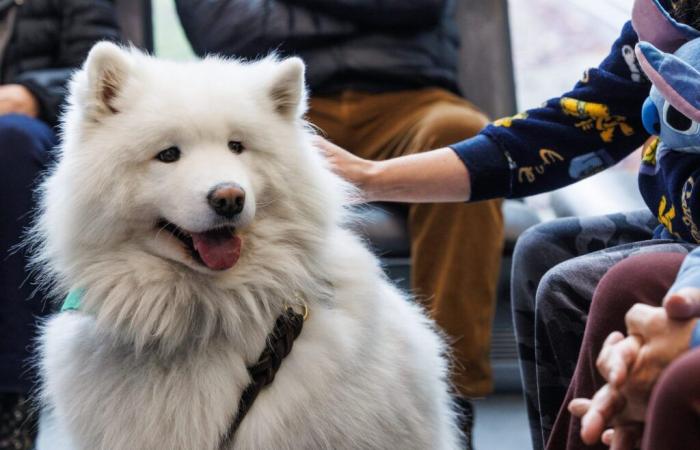As soon as Kozak stops in front of her in the waiting room, the patient who was there for a radiotherapy treatment reaches out to stroke the long, white hair of the Samoyed dog. With a sad and anguished face, she closes her eyes, her chin resting on the Stitch dog placed on her lap, her hand still in contact with Kozak. She wipes away a tear. “It calms down,” she whispered, after a moment, to the person who accompanied her.
“There are some pretty magical things happening,” immediately admits Isabelle Turcotte, psychosocial worker at the Leski Foundation.
Every Tuesday morning, she visits patients at the Montérégie Cancer Institute at Charles-Le Moyne Hospital, in the company of Kozak, a service dog. On Thursday, it is the turn of Simba, a blond Labrador, to be “his colleague” for these patients.
It only takes a few seconds to realize that Kozak is a true star. Seeing the dog at the door, a patient leaving the Institute exclaims: “Kozak! I won’t see him again, my appointments are on Mondays now.”
At each of her visits, Ms. Turcotte follows the same routine. When entering a waiting room, she makes sure everyone is comfortable around the dogs. Even if some patients are more reserved, all will end up flattering the big dog, who seems to be just waiting for that.
As he passes, we feel the smiles behind the masks. “A little bit of happiness in passing?” said Ms. Turcotte, approaching two patients aside.
It even allows a user to feed it. The latter gives him a few kibbles, one at a time. Obviously, Kozak is very interested.
“He thinks I'm giving him treats, but it's his food,” assures Ms. Turcotte, about the healthy dog weighing more than 62 pounds.
Pierre Laporte is waiting for his penultimate radiotherapy treatment for prostate cancer. He knows Kozak well. “It’s the reactions of others that fascinate me,” he says. My wife is not much of a dog, and every time, Mrs. Turcotte remembers this, and does not go to her. We're here to fight our bugs, but it's still fun.”
Bond of trust
Isabelle Turcotte has established a great bond of trust with her canine “colleagues”. “If he walks in one direction, it’s because there is a reason: he felt something before me, so I follow it,” she means, saying she is very attentive to what is happening around her.
Julien Terrier, deputy director of the cancer program, reports a moment when Simba stood on the feet of a patient, who had known she had cancer for barely three weeks.
She cried, for the first time since her diagnosis was announced. “It’s liberating,” sums up Mr. Terrier.
Collateral benefits
The initial idea of this cancer assistance dog project – a first in Quebec – was to provide another form of care to patients when they are diagnosed with cancer, a very stressful and anxiety-provoking moment, same as during the first treatments, which represent the unknown.
“Patients were asking if he will be there next time! It creates an anchor point that reassures.”
-Julien Terrier, deputy director of the cancer program
It is not uncommon for the dog's visit, however short it may be, to have the effect of opening a discussion between patients in the waiting room, who will talk to each other about what they are experiencing.
Another collateral effect: the benefits for employees and healthcare staff, faced with illness on a daily basis. During her tour, Isabelle Turcotte often stops with members of the staff.
“We always go fast, we walk very quickly. Kozak imposes his rhythm on us. And it puts a balm on the hearts of caregivers,” rejoices Julien Terrier.
In place for a year, the project could also be deployed in a more individualized approach.
During his visits, the assistance dog wears a scarf bearing the image of the Leski Foundation. He knows at that moment that he can go see anyone. When he wears a harness, it is an individual intervention.
“In our development, we would like to move to harness mode,” he notes. For example, to support people who are afraid of injections, or for people who are claustrophobic when they have an MRI during radiotherapy.”
Don anonyme
The project was made possible thanks to a private donation to the Charles-Le Moyne Hospital Foundation.
A couple, who wish to remain anonymous, approached the Foundation with the desire to contribute to a project that could include animals.
This played the role of matchmaker with the Hospital, while the Cancer Institute had already mentioned the idea of assistance and pet therapy dogs.
“It’s fun when you manage to find a program that thrills the donor. Everyone wanted it to work,” rejoices Nathalie Boudreau, president of the Foundation. The first steps were taken during the pandemic.
Wanting the project to prove itself, the couple offered the sum of $35,000 per year for several years.
The assistance dog project could well create new ones, not only within other hospitals which are eyeing the initiative with interest, but also in other departments of the Charles-Le Moyne Hospital.
It's not a lack of funding that's slowing these expansions, but rather a lack of dogs at the Leski Foundation.
Simba, Kozak and the Ski Foundation
Leski assistance dogs work in particular with victims of crime. For example, they can accompany children who have to testify in court. The Saint-Hyacinthe foundation also works with people living with a mental health disorder.
Some dogs are also called upon to intervene in primary and secondary school classes, with certain students, before stressful periods such as exams.
After passing a series of evaluation tests, the dogs that are selected by the Leski Foundation undergo initial general obedience training. They are then taught specific behaviors, such as “TTouch”.
“They detect anxiety before we do, because of saliva. In a waiting room, it will detect who is more stressed. The more he does it, the more natural it becomes for the dog,” explains the president of the Foundation, Marie-Hélène Paquin.
At Charles-Le Moyne Hospital, the Infection Prevention and Control Department of the CISSS de la Montérégie-Centre ensured that visits were safe. This is also why they are limited to waiting rooms, and why dogs do not enter treatment rooms.
Dogs must follow a certain vaccination record, and cannot eat raw meat, to avoid the risk of developing parasites. They are also educated accordingly, for example, not to lick patients' hands or faces.
Most of the dogs belong to the Foundation and live with foster families. It costs between $45,000 and $50,000 to train a dog and cover all of its care and food for its entire life.






